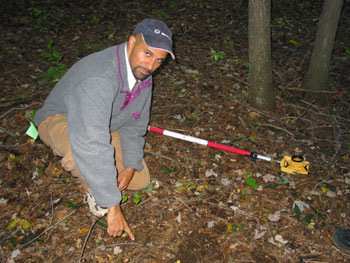GEOL/PHYS 241
 Taught by: Brian McAdoo
Taught by: Brian McAdoo
The Course
What is your course “Digital Underground” about?
Digital Underground: Field Geophysics uses state-of-the-art electromagnetic techniques to identify forgotten graves by measuring very subtle changes in the soil properties. These graveyards tend to be of the region’s dispossessed- largely slaves and poorhouse residents. Traditionally, “Applied Geophysics” uses the same tools to identify environmental hazards such as leaky underground storage tanks and the like. By incorporating an interesting local history aspect to the class makes it a lot more fun.
The Technology
How does this particular software tool enhance your teaching goals? Why is it better than other technologies or artistic techniques?
We use a Total Station surveying tool (a theodolite with laser rangefinder to locate objects and map elevations), an electrical resistivity meter (which measures subtle changes in the soil’s ability to conduct electricity), a cesium vapor magnetometer (which measures very slight changes in the earth’s magnetic field), and a ground penetrating radar (that shoots radio waves into the ground that bounce off buried objects or interfaces). We compile all the data in a GIS database that gives us 3D representations of the soil properties.
The Student Response
How have your students responded to your use of technology?
Sometimes the technology can be quite a hurdle to clear. Because this is a student-run, project based class, they often become more worried about addressing the problems at hand than the frustrations that sometimes accompany technological resources.
The Challenges
What are the challenges you faced teaching this class for the very first time?
I tell the students at the onset of the class that there will be bugs in everything we do. A power line that throws off the magnetometer readings. An exploded battery in the GPR. This is stuff they will have to deal with in the real world, so get used to it!
New Directions
Are there any new directions you would like to explore the next time you teach this course?
I would like to continue surveying graveyards, but I understand there is a site in Orange County where a homeowner has found some tunnels on her property with the initials of a local abolitionist carved into the support beams at the entrance. She believes this was a station along the Underground Railroad. The tunnels have since collapsed, so I think it would be a fascinating project to see if these tools can map these tunnels.
